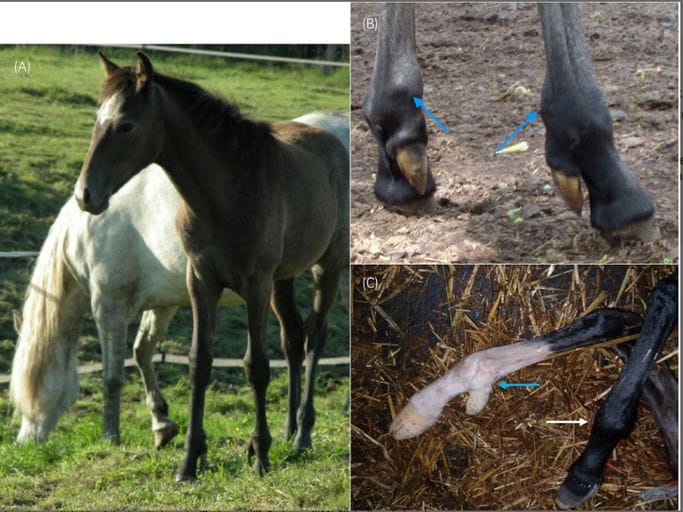- Veterinary View Box
- Posts
- New Study Uncovers First Inherited Polydactyly in Horses—Dominant Trait with Variable Expression
New Study Uncovers First Inherited Polydactyly in Horses—Dominant Trait with Variable Expression
Equine Vet Journal 2025
Ella Baville, Bianca Carstanjen, Aurélie Thomas-Cancian, Anne Calgaro, Nathale Bonnet, Laurent Tiret, Vincent Gache, Marie Abitbol
Background
Polydactyly, the presence of supernumerary digits, is a widely reported congenital limb abnormality across species but remains rare in horses. When it does occur, it typically affects the medial forelimb and has historically been described in isolated cases rather than multigenerational families. Although inheritance has been suspected, no molecular or pedigree-based evidence has previously confirmed genetic transmission in horses. This study aimed to characterize the phenotype of non-syndromic preaxial polydactyly within a Berber and Arabian-Berber horse family and to determine the most likely inheritance pattern.
Methods
The study retrospectively examined 43 horses belonging to a single extended family, including one previously reported polydactyl individual. Clinical examinations, owner-supplied photographs, and radiographs obtained by primary veterinarians were reviewed to identify and characterize limb anomalies. Cytogenetic karyotyping was performed in two affected and one unaffected horse to exclude chromosomal abnormalities. Pedigree data from 67 related animals were compiled to infer inheritance patterns.
Results
Nine horses exhibited polydactyly, eight on physical examination and one detectable only by radiography. All supernumerary digits were located medially on the forelimbs, with variable expressivity ranging from small cornified nodules to fully individualised digits with hooves. Radiographs revealed diverse anatomic presentations, including unilateral or bilateral involvement, differing numbers of supernumerary phalanges, and variation in the development of rudimentary metacarpal bones. Several clinically normal relatives displayed mild osseous changes, though these were not definitively linked to polydactyly. Karyotypes of affected and unaffected horses were normal. All nine affected individuals traced back to a single stallion, supporting autosomal dominant inheritance with incomplete penetrance and variable expressivity.
Limitations
Study limitations included restricted availability of radiographs, variable image quality, and limited sampling caused by confidentiality constraints and geographic distribution of animals. As some horses were evaluated only externally, additional radiographic-only polydactyl individuals may have gone undetected. No molecular genetic testing was performed, leaving the responsible locus unidentified.
Conclusions
This study documents the first inherited, non-syndromic preaxial polydactyly in horses and demonstrates a likely autosomal dominant transmission pattern with incomplete penetrance. Phenotypic expressivity was highly variable, spanning subtle internal abnormalities to well-developed extra digits. The findings highlight the importance of radiographic screening in relatives and suggest that breeding decisions should avoid pairing at-risk horses. Ongoing research aims to identify the underlying genetic mutation.

Variable expressivity of polydactyly in Berber and Arabian-Berber horses. (A—horse III4) Additional digits were observed on the medial side of the forelimbs only. (B—horse III7, C—horse III11) Clinically polydactyl foals from the family exhibited either an additional digit clearly visible on each forelimb, with a hoof and deformation of both fetlocks (B, blue arrows) or an additional digit with a hoof on one forelimb (C, blue arrow) associated to a medial deformation of the fetlock on the other forelimb (C, white arrow).
How did we do? |
Disclaimer: The summary generated in this email was created by an AI large language model. Therefore errors may occur. Reading the article is the best way to understand the scholarly work. The figure presented here remains the property of the publisher or author and subject to the applicable copyright agreement. It is reproduced here as an educational work. If you have any questions or concerns about the work presented here, reply to this email.